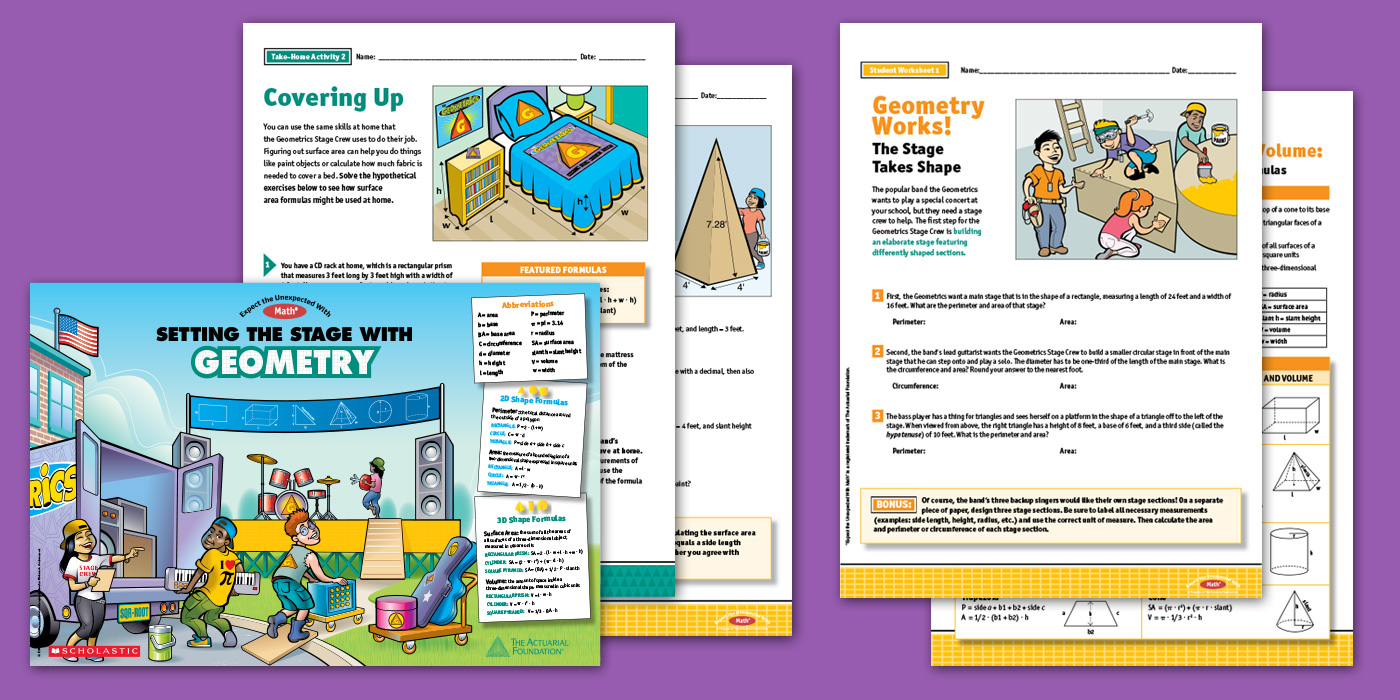Students will:
- Understand formulas used to measure the surface area of these basic 3-D shapes: a rectangular prism, a cylinder, and a square pyramid
- Make class sets of the Setting the Stage With Geometry Worksheet: That Should Cover It! printable and the Setting the Stage With Geometry Reference Sheet: Perimeter, Area, Surface Area, and Volume printable.
- Print a copy of the Answer Key: Setting the Stage With Geometry printable.
- Hang a copy of the Setting the Stage With Geometry Classroom Poster printable in your classroom or project it using a computer and projector.
- Optional: Make class sets of the Setting the Stage With Geometry Take-Home Activity: Covering Up! printable and the That's A Wrap! Bonus Worksheet printable for students to complete as part of the Lesson Extensions.
Introduction to Formulas for Surface Area
Step 1: Draw a rectangular prism on the board with these measurements: height = 3 feet, length = 4 feet, and width = 5 feet. Ask students to calculate the area of one of the surfaces, say 5 x 4 = 20 square feet. Repeat for the other surfaces. Point out that opposite surfaces have the same area.
Step 2: Show students the surface area formula for rectangular prisms on the Setting the Stage With Geometry Classroom Poster: SA= 2 (l • w + l • h + w • h). Explain to them that the surface area of 3-D objects is measured in square units, just like the area of 2-D objects, and is the sum of all of the 3-D object's 2-D surfaces.
Step 3: Demonstrate how to calculate total surface area for the rectangular prism you have drawn. The answer is 2 • (20 + 12 + 15) = 94 square feet.
Step 4: Now draw a cylinder and mark the dimensions with the radius at 3 feet and the height at 4 feet. Indicate that the surface area for a cylinder equals the area of the two bases plus the area of the surface between the bases. Demonstrate this to your class by using a rolled-up piece of paper to create a cylinder; use two paper circles (cut out beforehand) to fill in the bases. When you unroll the paper, students will see that the surface between the two bases is a rectangle when "unrolled" and that the formula simply adds the area of the bases to the area of the rectangle.
Step 5: Show students the surface area formula for cylinders on the Setting the Stage With Geometry Classroom Poster, SA= (2 • π • r2) + (d • h), and demonstrate how to calculate surface area for the cylinder you have drawn. The answer is (2 • 3.14 • 32) + (3.14 • 6 • 4) = 131.88 square feet.
Step 6: Finally, draw a square pyramid on the board and mark the dimensions with a base length of 6 feet and a base width of 6 feet. Show the slant height as 5 feet by drawing a perpendicular line from the center of one of the base sides to the top of the pyramid. The square pyramid has a base area (BA) measurable by l • w like any square or rectangle.
Step 7: Show students the surface area formula for square pyramids on the Setting the Stage With Geometry Classroom Poster, SA= (BA) + 1/2 P • slant h, and show students how to calculate the answer. This formula adds together the area of the base with the area of the four triangular sides of the square pyramid. The P in the formula refers to the perimeter of the base. The answer is 36 + 1/2 • 24 • 5 = 96 square feet.
Guided Practice
Step 8: In groups or in pairs, ask students to calculate surface areas for:
- A rectangular prism with the following measurements: length 3 meters, width 7 meters, and height 5 meters. 2(3 x 7 + 5 x 7 + 3 x 5) = 142 square meters.
- A cylinder with a radius of 6 feet and a height of 10 feet. 2 x 3.14 x 62 + 3.14 x 12 x 10 = 602.88 square feet, rounded to the nearest hundredth.
- A square pyramid with one side of the base 60 meters long and a slant height of 50 meters. The area of the base is 60 x 60 = 3,600 meters. The perimeter of the base = 4 x 60 = 240 meters. The surface area of the square pyramid is 3,600 + 1/2 x 240 x 50 = 9,600 square meters.
Step 9: Distribute the Setting the Stage With Geometry Worksheet: That Should Cover It! printable. Tell students they should complete all the questions.
Note: You may want to take some extra time in class to go over the bonus question, which introduces the formula for measuring the surface area of a cone: SA= (π • r2) + (π • r • slant).
Step 10: Check for Understanding: Go over all correct answers as a class, referring to the Answer Key: Setting the Stage With Geometry printable.
Provide the Setting the Stage With Geometry Reference Sheet: Perimeter, Area, Surface Area, and Volume printable for students who are having trouble remembering which formulas go with which polygon.
Use the following printables as extensions for this lesson:
- Setting the Stage With Geometry Take-Home Activity: Covering Up! printable
- That's A Wrap! Bonus Worksheet printable
- Grade 7: Geometry (CCSS 7.G.B.4 and 6)
- Grades 6–8: Make Sense of Problems, Reason Abstractly and Quantitatively, Construct Viable Arguments, Attend to Precision, and Look for and Make Use of Structure (CCSS MP1-3 and 6-7); NCTM Geometry
For more information, download the comprehensive Standards Chart: Geometry printable.





